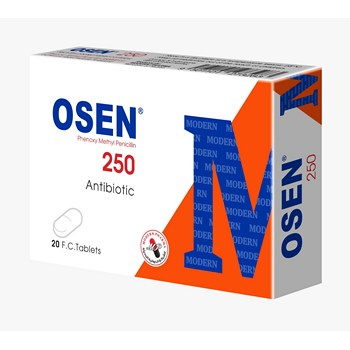OSEN250
- Phenoxymethylpenicillin, an antimicrobial acid, is a highly potent
antibacterial oral penicillin. It exerts its killing action on growing
and dividing bacteria by inhibiting bacterial cell-wall synthesis.
The spectrum of action is virtually identical to that of
benzylpenicillin. Phenoxymethylpenicillin has bactericidal action
against Gram-positive bacteria and may be less active against some
susceptible organisms particularly Gram-negative bacteria. It
covers group A,C, G,H,L, and M Streptococci, Streptococcus
pneumonia, non-penicillinase-producing Staphylococci,
Neisseriae, Erysipelothrix rhusiopathiae, Bacillus anthracis and
spirochetal species as well as numerous anaerobic agents are
also sensitive.
- Phenoxymethylpenicillin potassium is not effected by gastric acid.
Absorption is usually rapid and the potassium salt is better
absorbed than the free acid. About 80% is reported to be protein
bound.
- Phenoxymethylpenicillin is widely distributed at varying
concentrations in body and fluids. It is metabolized in the liver.
- Most of the applied dose is eliminated along renal pathways in an
unchanged form. Biliary elimination of the active drug is confined
to a minor fraction of the dose.


